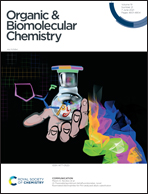Hydrogen-bond-driven dimers of naphthyridine derivatives for selective identification of DNA G-quadruplexes†
Abstract
G-quadruplex (GQ) ligands as potential anti-cancer drugs have received extensive attention. Large aromatic systems are usually considered in the design of the ligands to improve the binding with GQs, which are typically constructed by the combination of small modules with covalent bonds. In this study, we presented a non-covalent bond approach to construct GQ ligands with an extended planar structure. The ligands were stable dimers assembled through quadruplex intermolecular hydrogen bonds between two molecules of naphthyridine derivatives. Spectroscopic analyses showed that dimeric ligands could stabilize GQs with an increase of the melting temperature up to 12 °C and induced conformational conversion of hybrid GQs. Confocal fluorescence microscopy confirmed the enrichment of naphthyridine ligands in the nucleus. The ligands showed moderate cytotoxicity against HeLa cells with an IC50 value of 7.5 μg mL−1 and effectively induced growth inhibition and apoptosis in HeLa cells. These results confirmed the feasibility of the quick building of GQ ligands through intermolecular interactions of simple molecules that are easily obtained during synthesis, which is helpful for GQ ligand design and quick establishment of a ligand library through the self-assembly of easily available molecular components.

- This article is part of the themed collection: Chemical Biology in OBC


 Please wait while we load your content...
Please wait while we load your content...